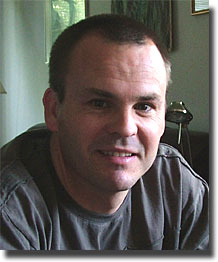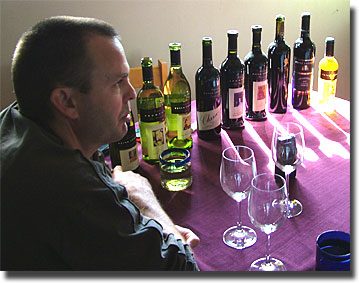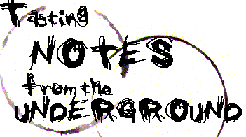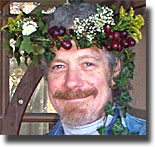|

a


Part 1 | Part 2

 e
get a steady stream of national wine trade reps coming
through Day-twah throughout the year, and occasionally they have a
winemaker in tow, as was the case in late June, when
Hess
Collection Central Region Sales Manager
Brian Batridge stopped in one morning at Gang Central,
accompanied by Ian Hongell (right),
of
Peter Lehmann Wines. Ian was on a two – week barnstorming tour
in the U.S., having already spent a week on the West Coast
“working the market” in L.A., San Francisco and the
Orange County area, before moving on to Ohio for four days,
and then finally spending three days in southeastern Michigan. e
get a steady stream of national wine trade reps coming
through Day-twah throughout the year, and occasionally they have a
winemaker in tow, as was the case in late June, when
Hess
Collection Central Region Sales Manager
Brian Batridge stopped in one morning at Gang Central,
accompanied by Ian Hongell (right),
of
Peter Lehmann Wines. Ian was on a two – week barnstorming tour
in the U.S., having already spent a week on the West Coast
“working the market” in L.A., San Francisco and the
Orange County area, before moving on to Ohio for four days,
and then finally spending three days in southeastern Michigan.
Already familiar with the important role that Peter Lehmann played in the development of the wine industry in Australia’s
Barossa Valley, I spent some time on the PLW website on the
eve of Ian and Brian’s visit, and while it is quite informative, it
doesn’t give much
background on Ian himself, so I started our interview there.
GoP: Ian, can you tell us a little bit about your background as a
winemaker?
Ian: I’ve always wanted to be a winemaker since I was a young
kid. I made my first wine when I was about seven, in an ice cream
bucket. We had some grapes in our back yard, and we just crushed ‘em and
let ‘em ferment. It wasn’t really good to drink, but it was wine.
Living in the Barossa Valley, my father worked at
Saltram, and I’ve always been around vineyards and wineries,
it’s just something I always wanted to do. I always wanted to have a
touch with science, but also with nature in an agricultural kind of way.
I like that sort of combination.
(During) the last few years of high school, (I) worked through the
cellars at Saltram. In ’88 I finished high school, deferred my college
for one year, worked vintage in the Hunter Valley in Australia,
then came back and did vintage in the Barossa in the same year, and then
I did vintage in Napa in the same year, so I did three harvests
in one year and thought, “This is different for me.”
I came back, did my three years of winemaking school, and came out with
a job at
Penfolds, and basically did a contract winemaking job there. The
harvest finished up, I was out of a job, pruning in my father’s vineyard
and I ended up getting a job in the middle of Australia, (at) a place called
Griffith and moved there. I went with a motorcycle and a backpack
and spent five years at a company called Cranswick Estate, which
became a public (traded) company on the Australian stock exchange, but
was subsequently bought out by
Evans & Tate.
So, I was part of that for five years, and we had a wine called
Barramundi, which is still selling today. It had an astronomical
rise from about 800 cases to about 300,000. I was the winemaker there; I
was originally employed as the assistant winemaker. So I went in and
said, “Well, what are we doing?” And they said, “Well, there’s the
winery, go for it.” Fair enough, we went in and we crushed a bit over
11,000 tons that year. At the end of the harvest, I said, “Well, what
are we doing,” and they said, “Oh, well you can be it (the winemaker)," so I
did that for five years, and left Griffith with great memories, a wife,
a house, no more motorcycle and a baby we didn’t know about!
I saw a job advertised at Peter Lehmanns in ’98, and thought that’s for
me, that’s where I really want to be, and thankfully, I got the job. So,
I joined Lehmann at the end of ’98 and have been there every since.
"Basically, we work as a team on every
wine, so we don’t have red winemakers or white winemakers, and it gives
us a huge strength in the sense that if someone’s having a bad day,
there’re other people around to support you."
GoP: I noticed on the PLW website that there are five winemakers
listed. Does everyone have their own individual
responsibilities?
Ian: We work what’s called the Lehmann system; not very many
companies do it this way anymore. Basically, we work as a team on every
wine, so we don’t have red winemakers or white winemakers, and it gives
us a huge strength in the sense that if someone’s having a bad day,
there’re other people around to support you. We use a majority rules
system, so consensus gets the decision, and you know what? Every time,
you end up making the right decision when it works that way.
During vintage, we break up into tasked responsibilities. With 190
growers and the number of wines that we’re producing, red systems, white
systems, fortified systems, sparkling wine systems, it’s too hard to
manage the cellar to take one wine all the way through, so we break up
into responsibilities and we hold those responsibilities for the entire
harvest. Once everything starts to calm down, my role basically reverts
to just running the cellar on a daily basis, organizing the program and
making sure that wines are being maintained to the level that we require
and that our program is met for bottling requirements and whatnot. Wines
are getting to the line on time, oak changeover is done in a reasonable
time and things aren’t forgotten and left behind.
GoP: You mentioned Saltram. Isn’t that the winery that created the
issues that caused Peter Lehmann to start his own winery?
Ian: Yeah, basically, in ’79, the Seagrams company wished to
purchase Saltram. At that time, it’s my understanding that they wanted
the site for their bottling (facility). They wanted to get spirits sent
to Australia and get them packaged and distributed. The only thing was, they didn’t want any grape growers,
and weren’t interested in wine, so they told Peter, “We’ll take (the
facility), but we don’t want grapes, please tell the growers their
grapes aren’t required next year,” and he couldn’t do that. He’d worked
with these families for many years, and knew all of them personally, and
he said, “Well, I can’t do that, this is where we part company.”
The sale went through, they purchased the site, and Peter said “How
about I lease some space from you, and rent the facility.” He told the
growers, “I don’t have the money to buy your fruit, but I’ll take the
grapes, turn it into wine and then when I get paid for the wine, you’ll
get paid for the grapes.”
 They
were in a rock and a hard place position, they had nothing else they
could do, so they agreed, they did that, the wine was sold, the growers
were paid and a lot of families were saved. While this was going on, the
site where Peter Lehmann Wines is now was built and then in the ’80
vintage, Peter took
Andrew Wigan, Leonie Lange,
Mick Anderson, some of the cellar staff and all the grape
growers to the new site and started Masterson Wines, named after
Sky Masterson from
Guys and Dolls. Sky Masterson was a gambler, and his card was
the Queen of Clubs, so on every one of our labels, you’ll see a
Queen of Clubs (left) with reference to that. In ’82, we changed it to
Peter Lehmann Wines, which was much
more fitting, and it’s been that every since. They
were in a rock and a hard place position, they had nothing else they
could do, so they agreed, they did that, the wine was sold, the growers
were paid and a lot of families were saved. While this was going on, the
site where Peter Lehmann Wines is now was built and then in the ’80
vintage, Peter took
Andrew Wigan, Leonie Lange,
Mick Anderson, some of the cellar staff and all the grape
growers to the new site and started Masterson Wines, named after
Sky Masterson from
Guys and Dolls. Sky Masterson was a gambler, and his card was
the Queen of Clubs, so on every one of our labels, you’ll see a
Queen of Clubs (left) with reference to that. In ’82, we changed it to
Peter Lehmann Wines, which was much
more fitting, and it’s been that every since.
GoP: It’s a great story.
Ian: Yeah, it’s pretty incredible. You know, if you’re a new
vineyard owner in Australia now, and you planted a vineyard, a bank
wouldn’t lend you money without a contract. But there are many of our
growers who still don’t have contracts and are from the old era, but
it’s just done on a handshake, and the company looks after them, and to
this day, we haven’t knocked any fruit back yet. We’ve taken everything
that our growers have produced.
"The little guys who are growing the
real special stuff in the hidden areas of the Barossa are as important
as the big guys out here who are growing large lots of Shiraz and
Semillon."
GoP: How many growers again?
Ian: Probably around 190 now. You know, the smallest grower
brings us grapes in the back of his little "ute" (slang for utility or
pick up truck), in buckets, a matter of
tens of hundreds of kilos, and the largest group of families is bringing
over a thousand tons, and there’s everyone and everything in between,
and they’re all important. The little guys who are growing the
real special stuff in the hidden areas of the Barossa are as important
as the big guys out here who are growing large lots of Shiraz and
Semillon.
GoP: So I would imagine that in the beginning, it was still a fairly
small production?
Ian: Well, believe it or not, the first vintage, 1982, was
actually the largest vintage until 2002. We hadn’t topped it (because)
there’d been a large period of vine pull, and, I guess, lack of
confidence to replant, but the winery wasn’t saying, “Hey, let’s go
plant, plant, plant,” and also, there was a varietal conversion time,
where a lot of unwanted varietals were grubbed out and new plantings of
Shiraz, Riesling, Semillon and Chardonnay were put in. I think that
Chenin Blanc, Grenache, Mataro, Cinsault, things like that, all
fortified varieties of grapes, were knocked out and replaced by table
wine varieties. So there was a bit of a tear out and a rebuild period,
and we’re now sitting around about 17,000 tons of
production.
GoP: How does that translate into cases?
Ian: We’re at around six to seven hundred thousand cases at
the moment.
GoP: That’s a pretty good sized production.
Ian: Yeah, but still, we’re really a medium sized winery in the
Australian wine industry. Now, with Hess, it’s not a comfortable
situation in a sense because you always have to perform, but we’re not
subject to those pressures that very small companies are who are
financially strapped and are now being de – listed in the sense of the
stock exchange. We aren’t subject to those direct pressures of being
listed and having to have 10% growth, 10% growth, 10% growth, otherwise,
your shareholders run away from you.
GoP: What is the relationship with Hess?
Ian: Hess bought into Lehmann in 2003, now just over 86%, I
believe, as the major shareholder. Peter Lehmann has roughly 10.1% of
ownership, and there were about 4% shareholders who would never sell,
sort of old diehard Barossans, growers, employees and friends of the
Lehmann family. They just won’t sell; it’s not about the money, it’s
just that sort of attachment.
GoP: Does Lehmann still retain control over the operation?
Ian: The beautiful thing with the relation we’ve had with Hess is
that, as it’s been put to me, “We bought you because we liked what you
were doing,” and they’re letting us continue to do that. To date, no one
at Lehmann has lost their job, there’s been no staff restructuring,
(there’s been) a great support in the market place in the States for us,
and yeah, we’ve just been going about our business.
GoP: It reminds me a little bit of the situation with
Tony Soter selling Etude to Beringer
– Blass. When I
interviewed him last fall, he said, “It
allowed me not to sell OUT the business, but to sell it UP."
Ian: Yeah, well we haven’t been told to do things differently,
we’re doing it the same way we know it. It would be foolish, I think,
for someone to assume they could understand what’s happening in a
viticultural region and suddenly start pulling strings on how to start
crafting wines. I think Peter’s got 50 – plus vintages under his belt,
Wig’s got 30 - plus vintages under his belt, Leonie’s got nearly as many
as Wig in her own way and I haven’t done me math, but I’m there from ’92
onward, so there’s a few numbers on the board and there’s a lot of
experience in the Barossa.
GoP: I came across something on the PLW website that I know nothing
about, and perhaps you can fill me in; what was the infamous
(Australian) government sponsored vine pull scheme in 1986 and ’87? What
was that all about?
Ian: Yeah, well, basically, grape prices had plummeted to all
time lows; either fruit had no value or it was $100 or $150 a ton, and
the government came in and said we’ve gotta recreate the demand for
grapes. They valued crops and paid people per acre to pull out their
vineyards. It was a two – edged sword, because a lot of the old garbage
varieties were removed, but there was some old Shiraz and old Cabernet
and old Grenache that we should perhaps lament over a bit that had been
(pulled), but I think the Barossa’s bounced back pretty strong.
 GoP: How many different wines do you make? I notice that you have
different “ranges” of wines produced. GoP: How many different wines do you make? I notice that you have
different “ranges” of wines produced.
Ian: We also make a lot of fortified. I think I added it up one
time and it was like 54 individual blends, so it’s quite a few wines.
We make wines that are only available at our
Cellar Door. We want
the experience to be special, we want people to come there and try
things that they can’t get anywhere else, so we’ve got quite a few wines
at the Cellar Door that you can buy no where else in the world.
GoP: I also noticed while touring the website that Peter Lehmann
Winery has a real commitment to the environment.
Ian: Absolutely. We have a
stated environmental policy, and we’re
trying to do things the right way. Many times that will cost more; we’ve
invested many dollars in a water treatment plant recycling our water,
reusing it for agricultural purposes once treated. It’s not cutting edge
technology, but we’re working it out as we go along, so we’ve had to
modify our treatment plant three times and make other additions along
the way. Our engineer’s been really hands on and (has) run with that and
is doing a fantastic job. (It’s) just reuse, recycle.
You can do it two ways; you can do it the good way or you can do it the
bad way, so you might as well do it the good way, and that’s not to say
that we’re perfect at it, but it’s an ongoing process. These days, it’s
an old site that we’re slowly trying to convert into a more friendly
site in that respect.
GoP: Some of your reds are listed as “Vegan friendly.” This is
something I’ve never seen from any U.S. winery; no one would even think
of such a designation.
Ian: Our whites aren’t because we use milk powder, but our reds
use no animal products.
GoP: Why the focus on that?
Ian: Because we get asked.
GoP: Really?!
Ian: Yeah, we get hits all the time, “Are your wines vegetarian,
are your wines Vegan?” They’re all vegetarian, but only the reds are
Vegan. We won’t change the way we make our whites…
Brian: They use milk powder.
Ian: It’s a very gentle fining agent; in my opinion, it’s
natural. When you see what happens, I can guarantee there would be no
milk in it, but we have to declare it, it’s a product we’re really
careful in using and we’re not going to change it.
Brian: Have you seen other wines promote that at all?
GoP: I’ve never seen it.
Ian: It’s really come from the UK market; there’s obviously a lot
of (dedicated) vegetarians and Vegans, and that’s our stance on our
winemaking. Vegans can be happy (with) Peter Lehmann reds.
While we had been talking, Brian had been busily
uncorking bottles of wine, so we commenced to
sampling them.
On to the wines of Peter
Lehmann===>>>
|




 e
get a steady stream of national wine trade reps coming
through Day-twah throughout the year, and occasionally they have a
winemaker in tow, as was the case in late June, when
e
get a steady stream of national wine trade reps coming
through Day-twah throughout the year, and occasionally they have a
winemaker in tow, as was the case in late June, when
 They
were in a rock and a hard place position, they had nothing else they
could do, so they agreed, they did that, the wine was sold, the growers
were paid and a lot of families were saved. While this was going on, the
site where Peter Lehmann Wines is now was built and then in the ’80
vintage, Peter took
They
were in a rock and a hard place position, they had nothing else they
could do, so they agreed, they did that, the wine was sold, the growers
were paid and a lot of families were saved. While this was going on, the
site where Peter Lehmann Wines is now was built and then in the ’80
vintage, Peter took
 GoP: How many different wines do you make? I notice that you have
different “ranges” of wines produced.
GoP: How many different wines do you make? I notice that you have
different “ranges” of wines produced.